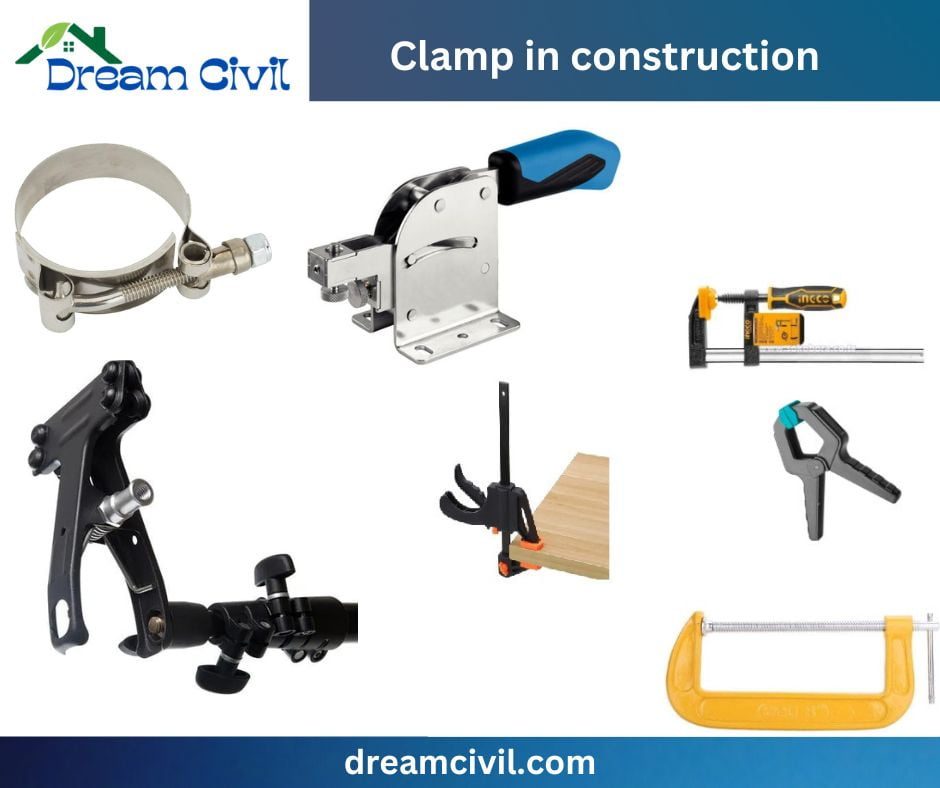Understanding Clamp in Construction: 20+ Types with Images, Pros & Cons, Including Uses

This post was originally published on this site
Table of Contents
✔ Clamps are indispensable for securing materials, ensuring precise joints, and providing stability in various construction applications.
✔ Explore how clamps are used in woodworking, metalworking, plumbing, automotive repair, crafting, DIY home improvement, carpentry, metal fabrication, and furniture making. Elevate your construction knowledge with this comprehensive guide to clamps.
1. What is a Clamp in Construction?
✔ Clamp is a versatile tool with broad uses in numerous industries and construction applications. The primary purpose of a clamp is to enthrall and stabilize objects securely.
✔ In construction, clamps are vital for ensuring the objects remain steadfastly in place.
✔ They offer resilience and backing throughout various construction tasks, making them an integral tool for experts and DIY enthusiasts.
2. 20+ Types of Clamp
3. Pros and Cons of Each Clamp
| Clamp | Pros | Cons |
|---|---|---|
| C-Clamp | ✔ Versatile for various tasks.
✔ Provides robust and stable clamping. |
✔ Limited throat depth for larger objects.
✔ Requires manual adjustment. |
| Bar Clamp | ✔ Long reach for securing large objects.
✔ Provides even pressure. |
✔ Bulky and less portable.
✔ Slower to set up compared to quick-release clamps. |
| Pipe Clamp | ✔ Designed for pipe-related tasks.
✔ Durable and provides a firm grip. |
✔ Limited to pipe-related applications.
✔ Less versatile for other materials. |
| Spring Clamp | ✔ Simple and easy to use.
✔ Lightweight and portable. |
✔ Limited clamping force.
✔ Not suitable for heavy-duty tasks. |
| Quick-Grip Clamp | ✔ One-handed operation for convenience.
✔ Quick-release mechanism for rapid adjustments. |
✔ Lower clamping force than some other clamps.
✔ Less suitable for heavy loads. |
| Toggle Clamp | ✔ Provides a secure grip.
✔ Holds workpieces in place effectively. |
✔ Requires a dedicated fixture or workbench.
✔ Limited to specific applications. |
| Band Clamp | ✔ Ideal for irregularly shaped objects.
✔ It can be used for large projects. |
✔ It may not provide as much pressure as other clamps.
✔ Band material can wear over time. |
| Corner Clamp | ✔ Holds pieces at precise 90-degree angles.
✔ Ensures accurate joints. |
✔ Limited to corner applications.
✔ Not suitable for non-right angle joints. |
| Parallel Clamp | ✔ Jaws remain parallel for even pressure.
✔ Suitable for high clamping force requirements. |
✔ It’s bulkier and heavier than some other clamps.
✔ Higher cost compared to basic clamps. |
| Vise-Grip Clamp | ✔ Locks securely onto various shapes and sizes.
✔ Provides robust and reliable clamping. |
✔ It can be challenging to adjust in tight spaces.
✔ It may leave marks on delicate materials. |
| F-Clamp | ✔ Sliding jaw for easy adjustments.
✔ Commonly used in woodworking and metalworking. |
✔ Limited throat depth for large workpieces.
✔ It may require extra support for stability. |
| Hose Clamp | ✔ Designed explicitly for hose applications.
✔ Prevents fluid leaks effectively. |
✔ Limited to hose-related tasks.
✔ Not suitable for general clamping. |
| Sash Clamp | ✔ Long and flat for woodworking tasks.
✔ Provides even pressure for gluing. |
✔ Limited to woodworking applications.
✔ Bulky and less portable. |
| Kant Twist Clamp | ✔ Ideal for spot welding, drilling, and bolting.
✔ It offers a firm and secure grip. |
✔ It may not provide high clamping forces.
✔ Limited to specific applications. |
| Locking Clamp | ✔ Ensures a secure grip for holding objects.
✔ Effective in keeping workpieces in place. |
✔ It may require manual adjustment.
✔ Less suitable for delicate materials. |
| Picture Frame Clamp | ✔ Designed explicitly for clamping picture frames.
✔ Ensures precise frame assembly. |
✔ Limited to picture frame applications.
✔ It may not be versatile for other tasks. |
| Marman Clamp | ✔ Heavy-duty band clamp for cylindrical objects.
✔ Provides a secure end-to-end connection. |
✔ Limited to specific cylindrical clamping needs.
✔ Bulky and less versatile. |
| Wire Rope Clip Clamp | ✔ Secures wire ropes effectively.
✔ It prevents slipping or loosening. |
✔ Specific to wire rope applications.
✔ It may not be suitable for other materials. |
| Screw Clamp | ✔ Versatile for a wide range of materials.
✔ Provides firm and adjustable clamping. |
✔ Requires manual adjustment.
✔ Not as quick to set up as some other clamps. |
| Flooring Clamp | ✔ Designed for clamping flooring materials.
✔ Holds large flooring pieces securely. |
✔ Limited to flooring applications.
✔ It may not provide as much pressure for other tasks. |
| Hand Screw Clamp | ✔ Compact size for tight spaces.
✔ Suitable for smaller workpieces. |
✔ Limited clamping force.
✔ Manual tightening may be required. |
| Quick Action F Clamp | ✔ Quick-release mechanism for rapid adjustments.
✔ Ideal for tasks requiring fast clamping. |
✔ It may not provide the highest clamping force.
✔ Less suitable for heavy-duty applications. |
| Drill Press Clamp | ✔ Secures workpieces on drill press tables.
✔ Provides stability during drilling operations. |
✔ Limited to drill press-related tasks.
✔ It may not be versatile for other applications. |
4. Uses of Clamp
I. Woodworking: Clamps help to hold pieces of wood together during gluing, cutting, or sanding.
II. Metalworking: Clamps provide stability when working with metal pieces, i.e., welding or shaping.
III. Construction: Clamps helps to ensure accurate and precise joints by securing materials during construction projects.
IV. Plumbing: Pipe clamps are subsidized to hold the pipes during plumbing installation and repair.
V. Automotive Repair: On automotive repair and installation, Clamps help to hold components together.
VI. Crafting: Clamps are beneficial tools for tying materials during crafting projects like sewing and painting.
VII. DIY Home Improvement: Clamps help to ensure accurate and precise joints by securing materials during construction projects.
VIII. Carpentry: Clamps help precise and sturdy joints by holding pieces of wood during carpentry projects.
IX. Metal Fabrication: Clamps are essential for hooking metal pieces during imitation processes such as cutting, bending, or grinding.
X. Furniture Making: Clamps play a paramount role in furniture making by holding pieces together during multitude and gluing.



Responses